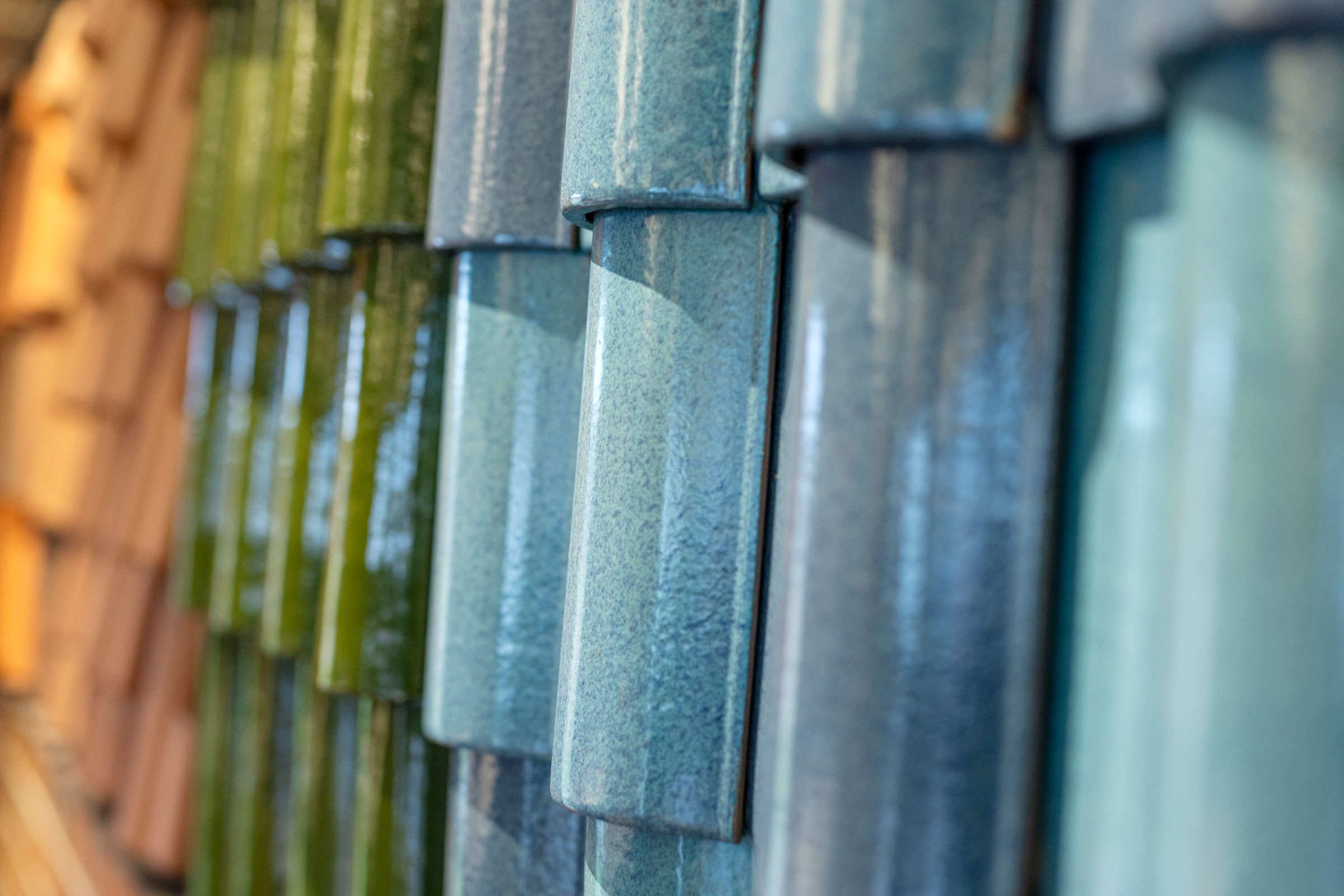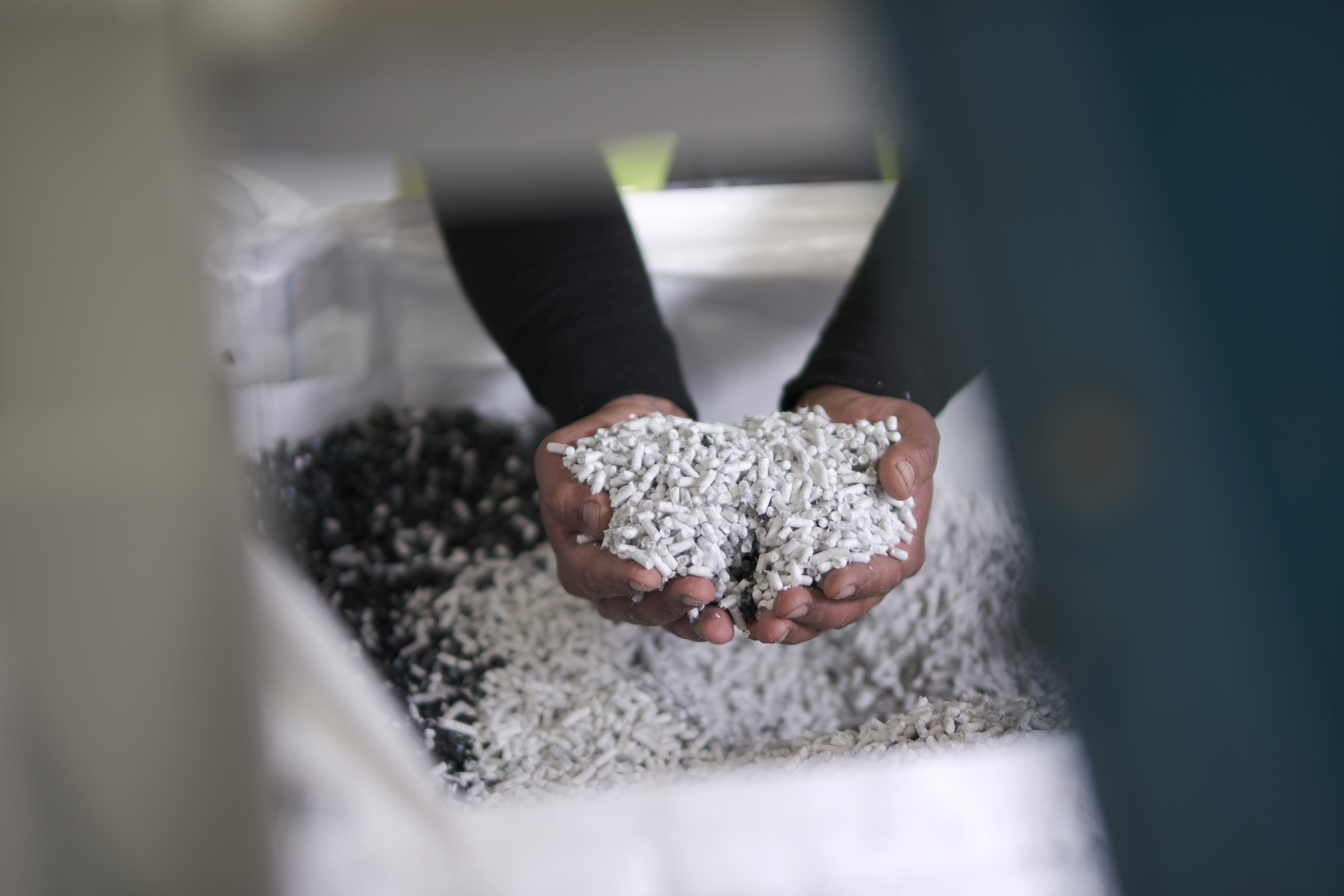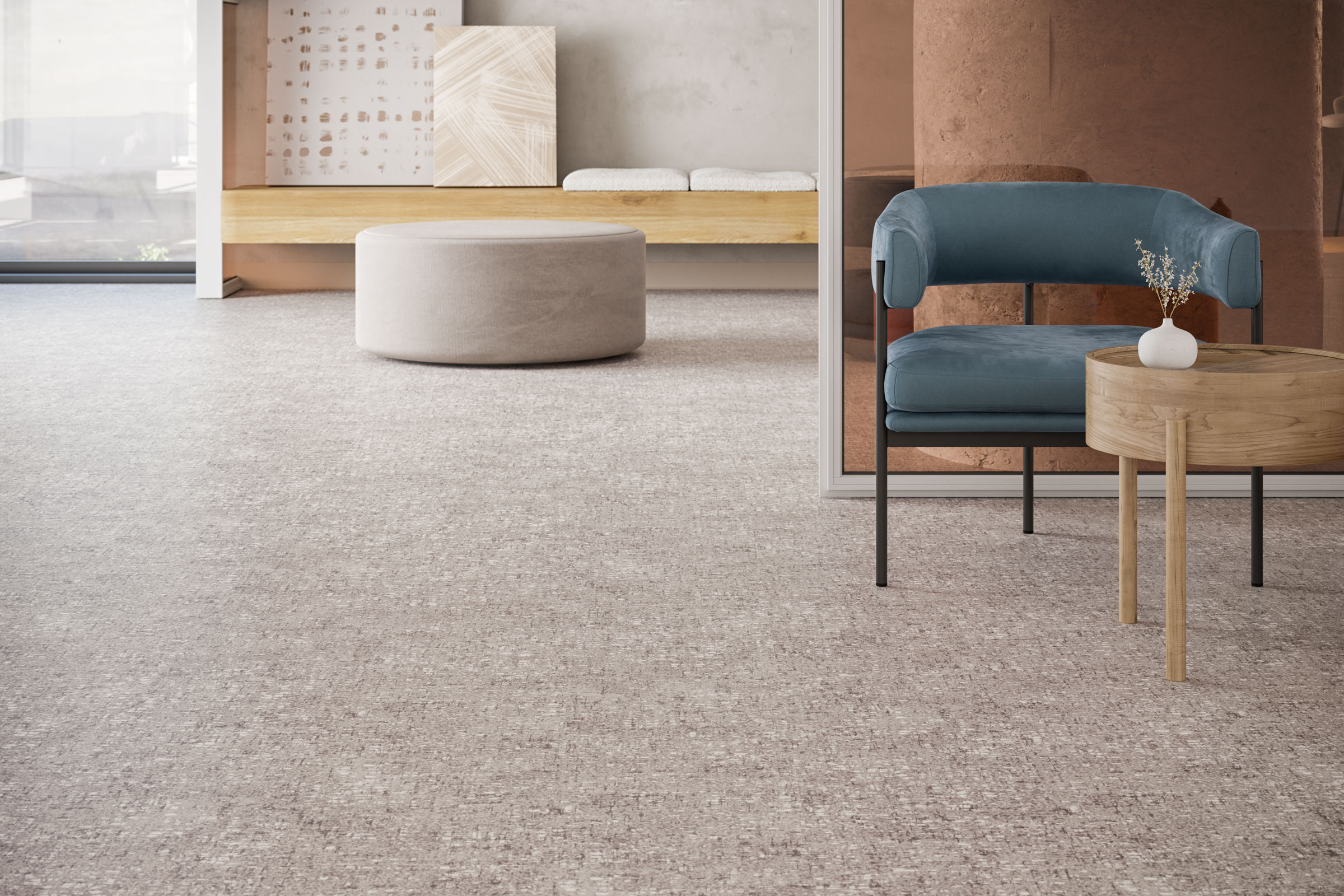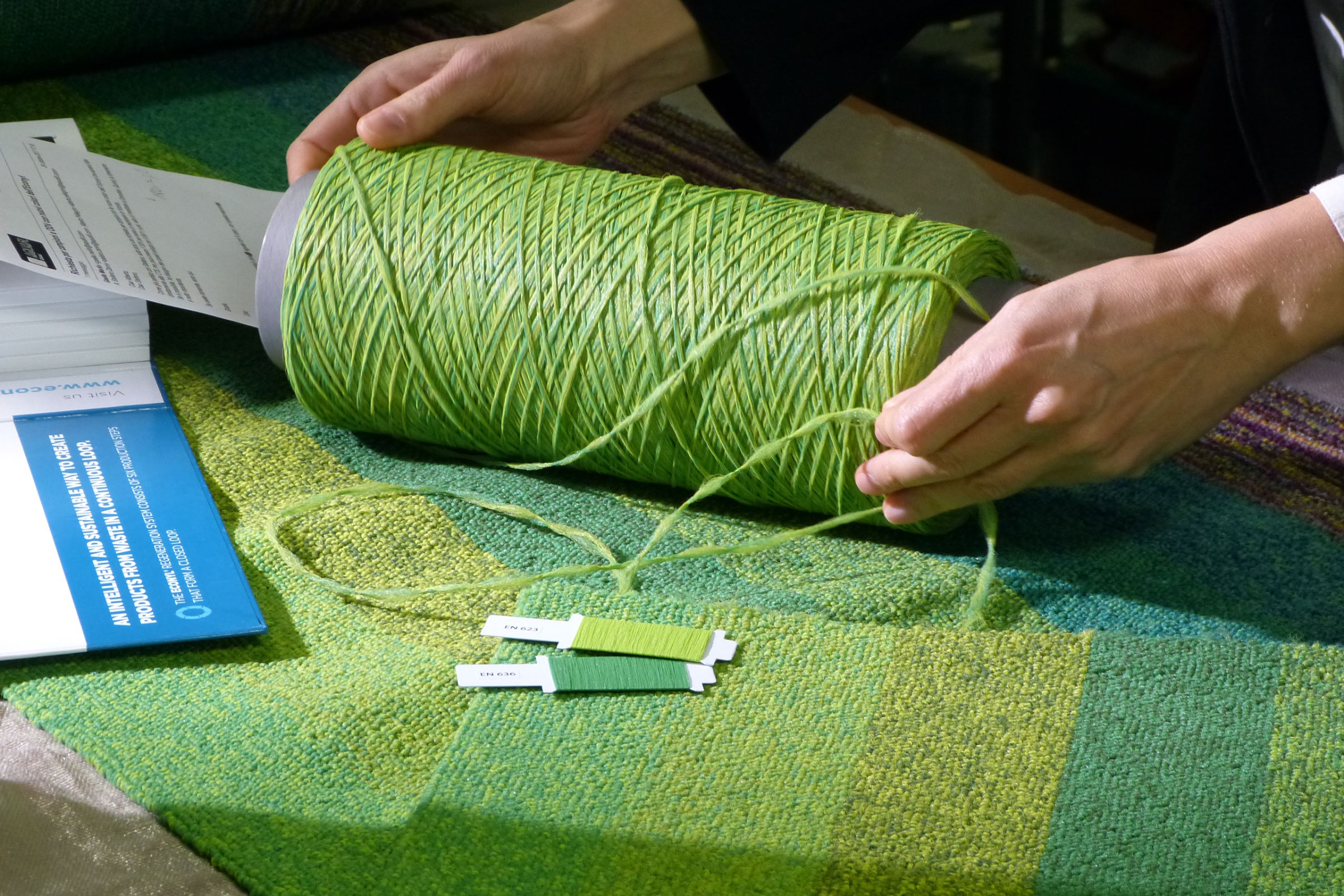Story at a glance:
- Circular design aims to create repairable, reusable, upgradable, and recyclable products that do not contribute to the global waste stream.
- Some tried-and-tested circular design strategies include dematerialization, designing for access over ownership, and choosing safe, circular materials.
- Companies like Aquafil, Tarkett, and Covestro have all integrated circular design strategies into their business practices.
According to the EPA, the average American produces approximately five pounds of trash per day, or roughly 1,800 pounds of waste annually—and that simply isn’t sustainable. “We can’t keep throwing things away. We have to keep finding solutions of how we reuse, recycle, and repair because of our limited resources. We need to be able to create that circular economy,” Roxane Spears, vice president of sustainability at Tarkett—a top flooring and surfaces manufacturer and leader in circular design—previously told gb&d.
In this article we cover the basics of the circular economy, take a look at six key circular design strategies, and explore a few examples of successful circular designs in action.
What is Circular Design?

Circular designs and products—like ECONYL regenerated nylon—do not enter the global waste stream at the end of their operational lifespans but instead reenter the economy by way of sharing, reuse, repair, remanufacturing, or recycling. Photo courtesy of ECONYL by Aquafil
Circular design refers to the practice of creating durable, repairable, reusable, and recyclable products that do not contribute to the global waste stream. Circular design is central to the concept of a circular economy, or a closed-loop system of production and consumption that looks to prolong the use of materials for as long as is feasible.
According to the Ellen MacArthur Foundation—one of the world’s leading charities committed to furthering circular design—the circular economy is “a system where materials never become waste and nature is regenerated. In a circular economy, products and materials are kept in circulation through processes like maintenance, reuse, refurbishment, remanufacture, recycling, and composting. The circular economy tackles climate change and other global challenges, like biodiversity loss, waste, and pollution, by decoupling economic activity from the consumption of finite resources.”
The Ellen MacArthur Foundation identifies three design-driven principles as the governing forces behind the circular economy: the elimination of waste and pollutants, the circulation of products and materials at their highest value for as long as possible, and the regeneration of natural ecosystems through the return of natural resources.
Why is Circular Design Important?
Each year the world generates approximately 2.01 billion tons of waste—the vast majority of which is not reused or otherwise recycled but instead finds its way to a landfill or is illegally dumped and left to pollute vulnerable ecosystems. This is often cited as a result of living in a world whose economic systems are primarily based around the linear “take, make, throw away” model of production and consumption.
Circular design and the circular economy as a whole rejects this philosophy, seeking instead to replace it with a cyclical “take, make, reuse” model that prevents waste from being produced in the first place. By continuously recirculating materials and products, the circular economy reduces dependency on new raw materials, which in turn helps protect the environment by minimizing habitat disruption and biodiversity loss caused by the over-extraction of resources.
When implemented at scale circular design reduces the environmental impact of human activities and actively encourages damaged ecosystems to regenerate, something that can help combat anthropogenic climate change via the expansion of natural carbon sinks.
6 Strategies for Circular Design
The Ellen MacArthur Foundation has identified six core strategies as being integral to circular design.
1. Prioritize Reuse Over Recycling

Once carpet is properly collected and recycled, it can be turned into raw material and reused for a variety of new products. Photo courtesy of Aquafil
There are two basic cycling pathways at play in the circular economy: biological and technical. Products in the technical cycle are meant to be used rather than consumed and are typically composed of finite resources. These resources initially enter the economy via parts manufacturers; those parts are then sent to product manufacturers before the products themselves are shipped off to service providers and distributed to customers.
The cycling aspect begins once the consumer decides they no longer need the product and wish to get rid of it. The technical pathway provides multiple avenues—such as being shared with another user, returned to the service provider for reuse/redistribution, sent back to the product manufacturer for refurbishment, or recycled by the parts manufacturer—for a material’s reentry into the economy.
Each method of reentry varies in terms of comparative value, with sharing, reuse, and redistribution typically considered to be more valuable than refurbishment, remanufacturing, and recycling as they retain more of the product’s embedded value by keeping it whole. Many companies have begun designing their products to be easily recycled, but the best circular designs prioritize maintenance and reuse.
2. Provide Access Over Ownership
A successful circular economy asks us to interrogate the idea of ownership and consider shared access as a viable alternative. This notion is born out of the realization that, more often than not, customers only require temporary access to a product, after which point the product may be passed on to a new user or returned to the service provider for redistribution.
This strategy has become extremely popular in recent years, with many companies building their entire business model on subscriptions, rentals, leases, or direct sharing instead of selling a product to their customers forever.
The residents of Schoonschip Amsterdam—a floating community built on the twin ideas of sustainability and regeneration—for example, have reduced their individual reliance on personal vehicles by partnering with Hely, a sharing mobility platform that allows members to share cars, electric bicycles, and cargo bikes between one another.
It should be noted, however, that this strategy cannot be applied to all products, as the elimination of customer ownership in certain situations can result in the formation of oppressive or predatory relationships between service providers and their customers.
3. Design for Longevity

Ludowici’s careful selection and treatment of clay bodies, combined with a high-heat firing process, ensures their terra-cotta tiles last for upwards of 75 years. Photo courtesy of Ludowici
Seeing as one of the three principles of circular design is the circulation of materials and products for as long as possible, it should come as no surprise that designing for longevity is one of the concept’s core strategies. By definition, a product or material that remains in use for a long period of time—either by resisting damage and wear or retaining its emotional appeal—reduces waste and prevents further extraction of raw materials.
Ludowici, for example, is one of the world’s leading manufacturers of terra-cotta roofing tiles and understands the value of longevity. As a roofing product terra-cotta tiles are already more supportive of a circular economy than, say, asphalt-based shingles, both due to their use of a low-impact material and longer lifespan. Most terra-cotta tiles manufacturers guarantee anywhere between 30 and 50 years of operational use compared to the 20-year average of most asphalt shingles.
Ludowici, however, has extended this already admirable lifespan to 75 years, a feat resulting from the company’s commitment to using only the best clay body for their tiles. All of Ludowici’s clay body is mined locally and run through filters to ensure quality before it is mixed into actual clay. Once mixed and formed, the tiles are then fired at high temperatures to fully vitrify the clay without warping or decaying—something that not all companies do.
“It’s a tricky balance,” David Jensen, sample coordinator, glaze production scheduler, and color consultant at Ludowici, previously told gb&dPRO. “At other companies it can be common to play it safe and fire the clay at a lower temperature. But the downside is that it makes it more likely that the clay will absorb water and be less durable over time.” Ludowici’s design process has been perfected over the company’s 135 years in business, with many of their oldest tiles still in operation today.
4. Make Safe & Circular Material Choices
Because products and materials within the circular economy are designed to be in circulation for the long-term, it’s important they do not contain toxic compounds or ingredients that might cause immediate or future damage to human and/or environmental health.
The catalog of harmful ingredients is ever-growing as new research is conducted, making it difficult to keep track of which substances are toxic and which aren’t. Fortunately the International Living Future Institute (ILFI) maintains the Red List—a comprehensive guide to the “worst in class” chemicals and chemical compounds that are known to cause human and environmental harm.
Designers can also use the Cradle to Cradle Products Innovation Institute’s material guidelines to make safe and circular choices. If certain chemicals can’t be completely phased out of a product’s design, Cradle to Cradle recommends using them as sparingly as possible and to either offer the product as a service or design a take-back program to prevent the chemicals from entering the waste stream.
5. Reduce Material Needs

In 2020, Autex Acoustics conducted a dematerialization project that led to 30% reduction in raw material usage for their core product. Photo courtesy of Autex Acoustics
Dematerialization, or the act of reducing a design’s overall resource requirements, is central to the implementation of a circular economy. Dematerialization can be achieved through the strategic redesign of a product so that it requires fewer materials to create or by virtualizing a service and offering a digital product (e.g. eBooks) rather than a physical one.
Autex Acoustics—a leading manufacturer of innovative and sustainable acoustic solutions—demonstrated the power of redesign as a means of reducing material needs in 2020 with their dematerialization project, which ultimately reduced raw material use by 30% for the core product.
Dematerialization can also be as simple as rejecting the use of a material or product in the first place, something that has become increasingly common within the built environment. “People are asking the question, ‘Do we even need a floor here?’” Allison Smith, vice president and sustainable design leader at HKS, told gb&d in a previous article. “Instead of installing flooring they are doing sealed concrete and identifying the needs of different spaces.”
6. Design for Repair & Upgradability
Finally, the circular economy asks us to forgo the wasteful concept of planned obsolescence and instead create products that are designed to be easily repaired or upgraded in the future to suit changing needs—that is, it asks us to design for modularity.
This strategy can be worked into the design of many products, but is perhaps best suited to electronic devices like smartphones, as such products are composed of many different parts—all of which typically possess wildly variable operational lifespans. Under our current economic model users are encouraged to replace entire devices even when only one of these parts is faulty, with many electronics providers intentionally designing their products to be difficult to disassemble and repair.
Modular electronics, on the other hand, are designed to be easy to disassemble, allowing users to remove individual components at a lower incurred cost. This ease of replacement and repair has the added benefit of making products easier to customize or upgrade, making them more capable of adapting to users’ diverse, ever-changing needs and ensuring they remain in use for long periods of time.
3 Examples of Circular Design in Action
Here are a few real-world examples of circular design from the field.
1. ECONYL Regenerated Nylon

Aquafil works closely with its customers on a concept they call “Born R2R,” or born regenerated to be regenerable, to encourage them to create products with eco-design in mind. Photo courtesy of Aquafil
Nylon, a form of plastic, is by no means an environmentally sustainable material—but the fact remains that there is already a considerable amount of plastic already in circulation that isn’t going away anytime soon. This represents a large stock of existing resources to find innovative uses for within a circular economy.
“Nylon is a versatile material that plays an integral role in almost every product—from flooring to furniture to textiles in automotive and fashion, Giulio Bonazzi, chairman and CEO of Aquafil, a leading supplier of yarn and synthetic fibers, previously told gb&d. “However, we needed to find a way to reduce its environmental impact. Nylon is typically made using oil derivatives that are high energy-consuming and high emission-producing. But how do you change a material we’ve been using for more than 100 years?”
Enter ECONYL® yarn, Aquafil’s regenerated nylon fiber that’s helping the textile industry pivot towards a circular economy. Introduced in 2011, ECONYL yarn is made from 100% plastic waste, at least 50% of which is post-consumer certified. Thanks to Aquafil’s unique regeneration process, ECONYL can be infinitely recycled without losing quality.
“Resilient design goes with the quality of the product. When we produce ECONYL, we use waste to produce it, but the way we produce it through chemical recycling, not mechanical recycling, gives us the possibility to keep the quality of nylon as good as if it was coming from crude oil or as good as nylon used for the first time,” Gaëlle Merlin, design and development manager at Aquafil, previously told gb&d. “ECONYL is not only a 100% regenerable product, but it’s also a product of first choice quality. It’s made to last.”
Aquafil recently announced their Born Regenerated to be Regenerable (Born R2R) project, which looks to engage manufacturers within the carpet industry to co-design circular carpets made from ECONYL (amongst other compatible ingredients) that can be repurposed and regenerated at the end of their operational lifespans. Carpets and rugs bearing the Born R2R logo are designed to be disassembled, with those parts made with ECONYL yarn destined to be recovered and reused via the ECONYL regeneration process.
2. Tarkett Flooring

Tarkett’s ReStart program helps prevent old flooring materials from becoming waste. Photo courtesy of Tarkett
Tarkett, a leading manufacturer of sustainable flooring solutions, practices circular design in multiple ways, not least of all via their ReStart® program. A hassle-free flooring take back and recycling program, ReStart’s number one goal is to prevent any flooring material from being sent to the landfill by collecting used flooring for reuse in new products, either by Tarkett themselves or their partners in other industries.
The ReStart recycling and reuse program helps preserve natural resources by minimizing the need for raw material extraction, reduces carbon emissions that would otherwise be incurred during the transformation of virgin materials, and aids projects in reaching their green building targets through the provisioning of recycled-content products.
Tarkett has also started experimenting with new methods for breaking down old flooring into usable raw material. In June 2024, the company announced that they had partnered with Mycocycle, a revolutionary nature-inspired biotech company that uses mycelia, or mushroom root systems, to decompose construction waste streams. The partners will continue to test the effects of mycelium on various types of flooring—collected through Tarkett’s ReStart program—and explore the possibility of using the resulting byproduct as a key ingredient in new flooring products.
“This partnership is rooted in a shared investment in the exponential power of collaboration and innovation,” Eric Daliere, CEO of Tarkett North America, said in a press release. “Together, we share a commitment to creating a circular economy that protects our natural resources, promotes climate health and sustains every living thing.”
3. Covestro

Covestro offers MDI—a core component of high efficiency rigid polyurethane insulation—in a climate neutral version through the use of bio-waste as an alternative raw material. Photo courtesy of Covestro
Covestro is one of the world’s leading manufacturers of high-quality polymer materials and is a massive proponent of the circular economy within the plastics industry. “At Covestro we believe in the circular economy as a driver of innovation and prosperity, and this belief continues to deeply inform our investments in next-level green technology for the plastics industry,” Richard Skorpenske, head of sustainability and public affairs at Covestro, previously wrote for gb&dPRO.
“We have forged alliances all along the value chain, from raw material suppliers to technology developers to our customers. We’ve also cleaned up our own operation, moving to more renewable energy sources. We are using research to push the boundaries into chemical recycling, which, while still in its infancy, could have massive repercussions for recycling plastics on a massive scale.”
Covestro has taken steps to dematerialize its operations, exemplified by the company’s recent announcement regarding IMAGIO® CQ, a new digital sampling tool that replaces the need for physical sampling. Covestro has also made major advancements in the use of alternative raw materials. In 2021, for example, the company started offering a new toluene diisocyanate (TDI)—a core building block in polyurethane foam—obtained via mass balancing from biomass waste. The following year, Covestro developed a breakthrough technology for producing the base chemical aniline (crucial to the production of methylene diphenyl diisocyanate, a chemical used in the creation of insulating foams) from plant biomass.
Beyond these advancements in safer and more circular raw materials, Covestro has also invested heavily in furthering circular economy education. Shortly after announcing their commitment to adopting circular principles in 2020, Covestro began working with the University of Pittsburgh’s Mascaro Center for Sustainable Innovation and Swanson School of Engineering to develop a graduate program focused on the advancement of circular economy design solutions. Released in 2022, the Covestro Circular Economy Program was designed to provide graduate students and PhD candidates with opportunities for the research, education, and innovative advancement of circular economy principles.




